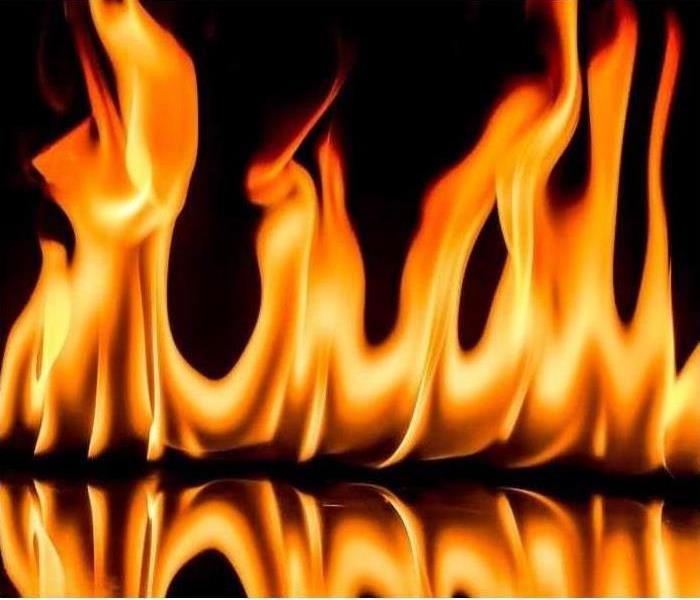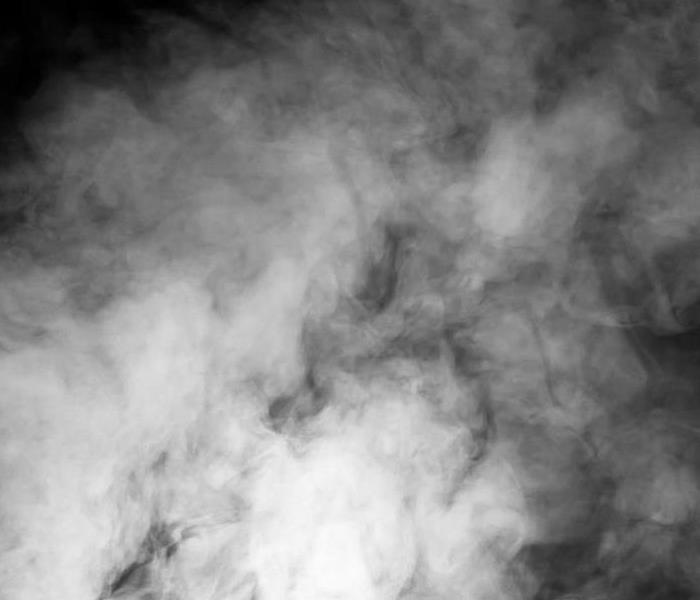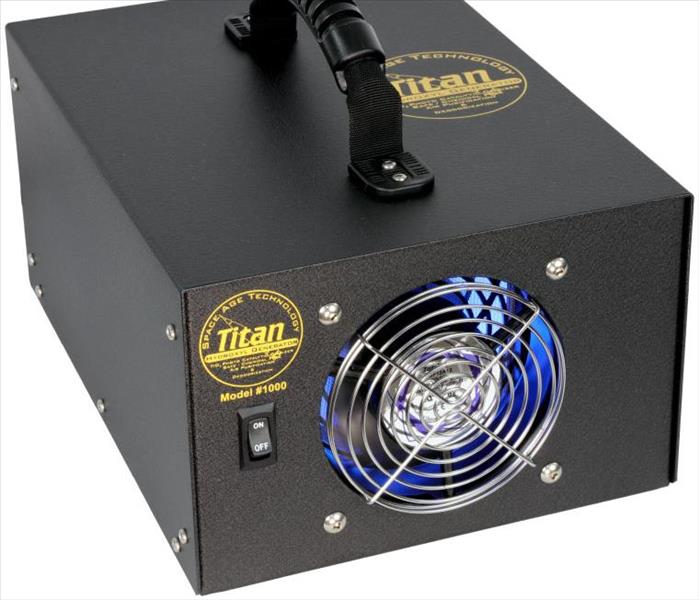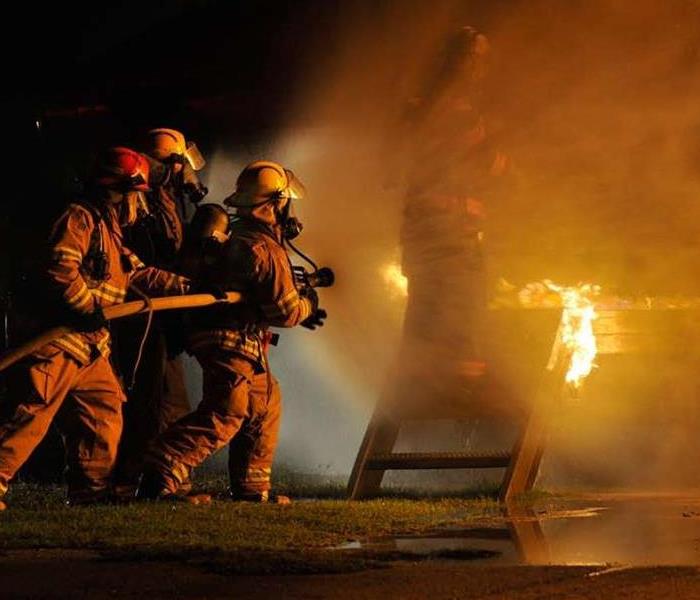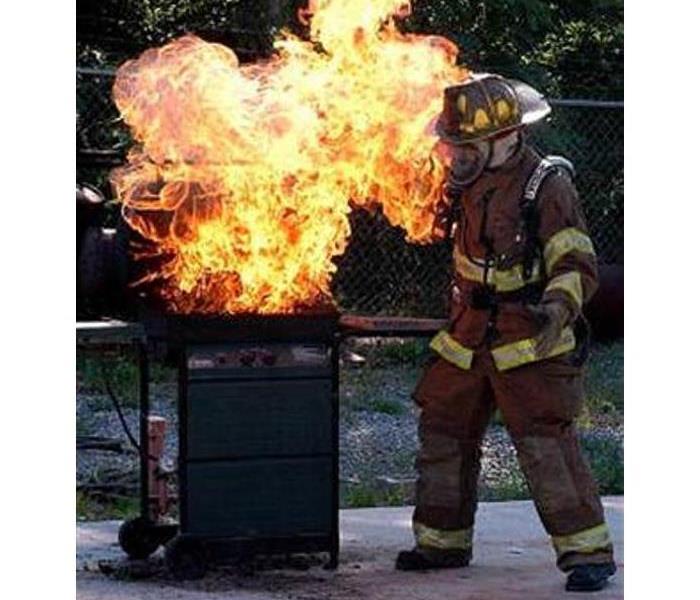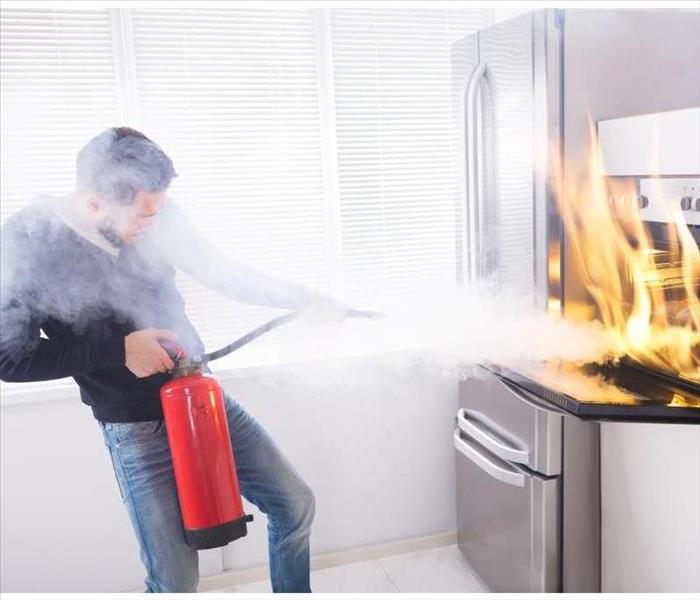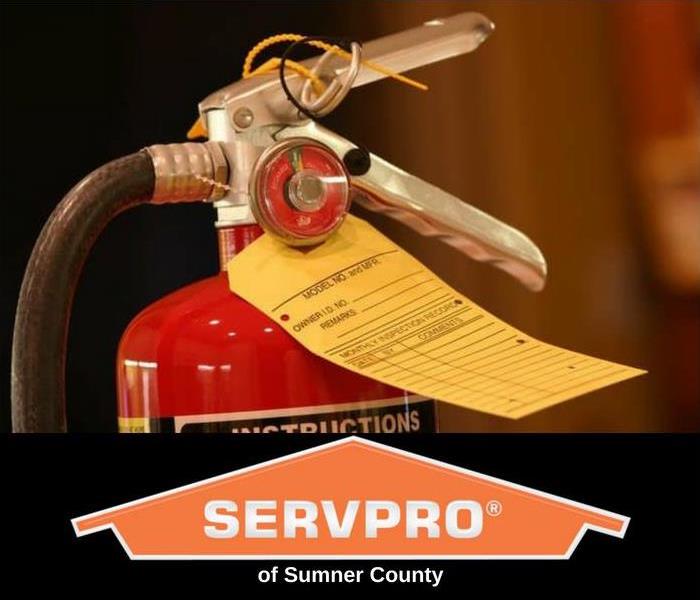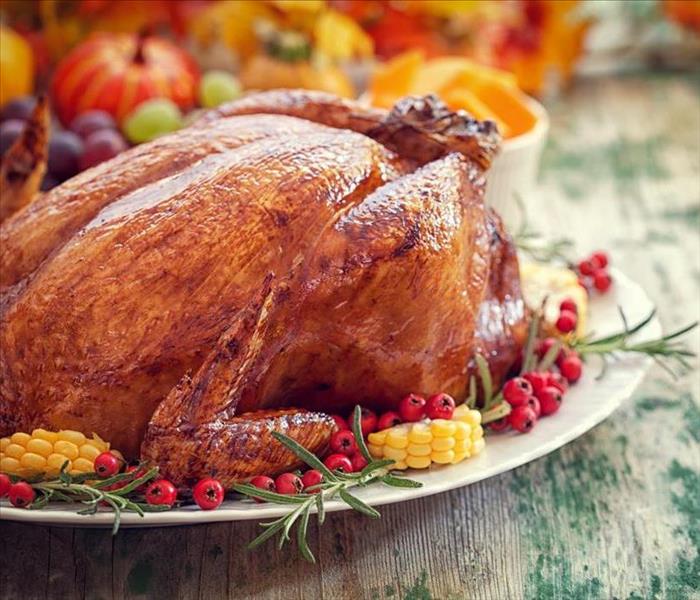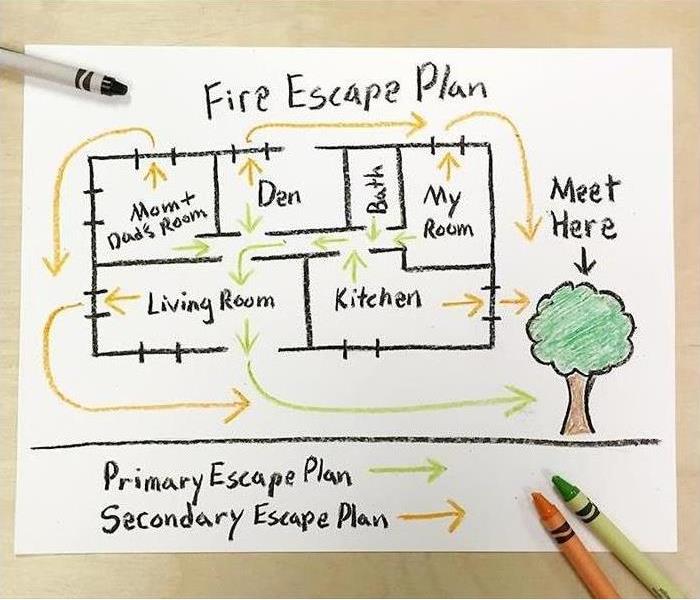Recent Fire Damage Posts
Holiday Fires
12/5/2024 (Permalink)
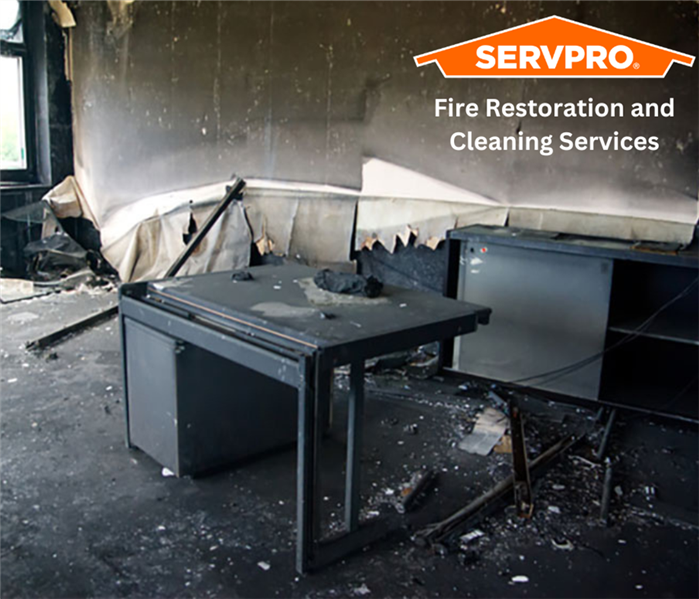 Fires can occur at anytime however we seen more of them around the holidays
Fires can occur at anytime however we seen more of them around the holidays
Most homeowners are aware holiday decorations should be used with care. Each year, statistics tell the story of the fire danger resulting from frayed wires, proximity to heat sources, and lights left on unattended. But disaster recovery specialists SERVPRO® wants homeowners to know that the danger of fire caused by holiday decorating, and by Christmas trees specifically, actually increases after the holiday. Citing research from the National Fire Protection Association (NFPA)*, the fire and water damage experts at SERVPRO say while four out of five Christmas tree fires happen in December and January, the 10 days with the highest average number of fires were all after Christmas Day.
"For many families, preparing for the holiday season is a very busy time," said Sue Steen, SERVPRO Industries, Inc. chief executive officer. "Come December 26, it's tempting to relax and stop watering the Christmas tree, replacing bulbs in outdoor lights and tucking indoor garlands back into place. Dry greens, open sockets and decorations that slip dangerously close to light sockets or fireplaces can all increase the risk of fire in the days after the Christmas holiday."
The American Christmas Tree Association** quotes Nielsen research that says Americans purchased 21.6 million live Christmas trees in 2011. That number is significant because, according to the NFPA, Christmas trees remain the number one culprit in holiday fires. Forty-three percent of Christmas tree fires happen in December, but January is close behind, claiming 39 percent -- numbers that demonstrate the danger of allowing Christmas trees to dry out during and after the holiday season. Tragically, Christmas tree fires are particularly deadly, claiming on average one life in every 40 fires compared to an average of one death per 142 total reported home fires.
Steen encourages homeowners who choose to decorate with live Christmas trees to be diligent about watering their trees both before and after the holidays. "When a Christmas tree dries out, it takes only a single spark from the fireplace, a draft that blows a candle flame too near, or a carelessly held cigarette to turn your holiday celebration into a tragedy," says Steen. "Beyond the damage from the fire itself, a Christmas tree fire, like any fire, can result in extensive smoke and water damage throughout your home, and can even be deadly."
As the holiday season moves into full swing, SERVPRO reminds homeowners to take common sense precautions based on a clear understanding of the potential danger to help prevent holiday traditions from turning into a holiday nightmare.
The Dangers of Frying a Turkey
12/4/2023 (Permalink)
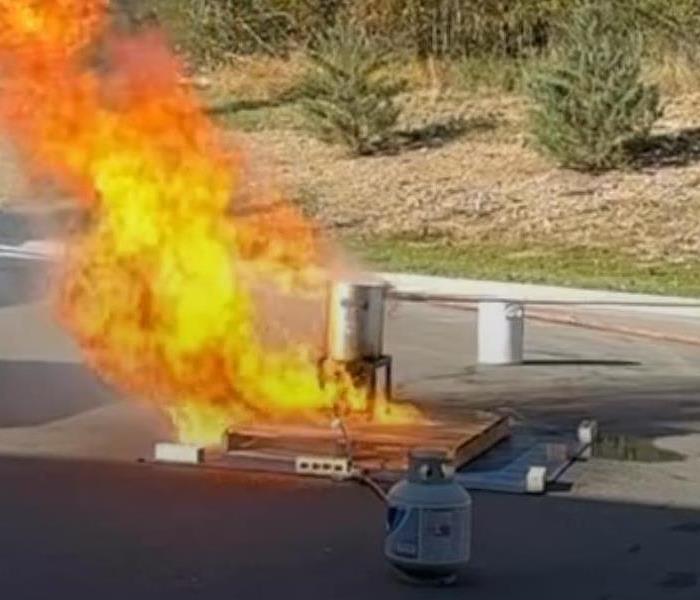 The fire department drops a frozen turkey into a fryer
The fire department drops a frozen turkey into a fryer
We were happy to partner up with the Hendersonville fire department to demonstrate the dangers of dropping a frozen turkey into a fryer. If you are cooking a turkey make sure it has plenty of time a thaw. Do not drop it in the oil quickly. You want to ease it down slowly. Make sure your fryer is outside and you have a fire extinguisher present.
We offer continuing education throughout the year for insurance agents and adjusters. We provide classes that cover water damage and mold, but our most popular class is always the thanksgiving fire remediation class.
After the class is complete we head outside where the fire department already has the oil heated up. They drop a frozen turkey into the fryer and what happens next is crazy.
Here is a really good video of the event this year. The fire department does great job showing you what can wrong when frying a turkey. While also giving you great advice on how to do it the right way.
Frozen Turkey Fire
Fire Prevention
7/25/2023 (Permalink)
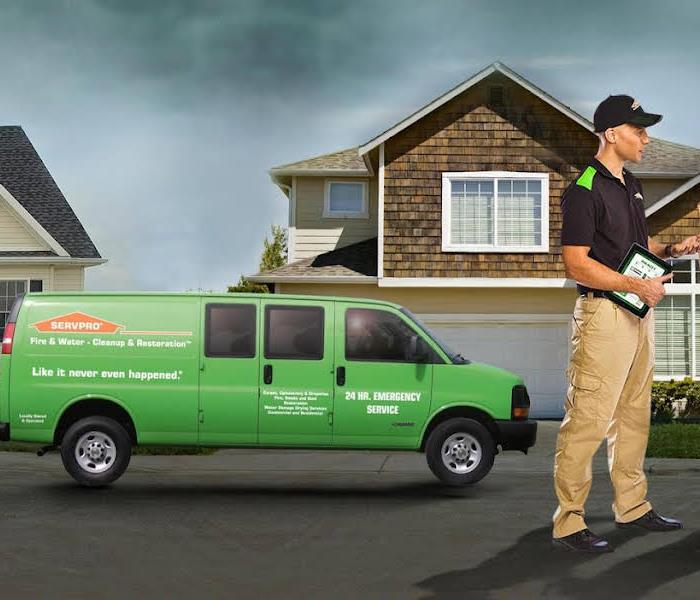 SERVPRO preparing to clean a fire damage
SERVPRO preparing to clean a fire damage
Fires are one of the worst events that can happen to a home or business. Often they are unpredictable and sudden. However, there a few things you can do to help prevent a fire. While this doesn't guarantee you will never have one, it drastically lowers your percentage.
-Inspect Smoke Detectors
When a fire starts a working smoke detector can not only save you money, but it could also save your life. It is recommended to test them monthly and frequently exchange the batteries. It only takes a few minutes to test them and its recommended to completely replace the detectors once every ten years. If your house has more then one floor its best to have detectors on each level and especially one close to each sleeping area.
-Watch Your Appliances
Stoves, washing machines, and microwaves all make our lives easier. However, when not used properly they can easily start a fire. Its recommended to clean these appliances regularly and not to use them when nobody is present.
-Be Extra Safe in The Kitchen
Recent studies have show that over half of house fires start in the kitchen. It’s important make sure you keep a fire extinguisher in close reach of the kitchen. Grease fires are most common in this area. It’s important to know that you must treat a grease fire differently than a regular fire. Never use water to put out a grease fire. Instead try to cover the fire with a heavy metal lid or dump baking soda directly on it.
-Don’t Smoke Inside
We don’t recommend smoking period. However, if you do please step outside and dispose your cigarette butts in a safe place.
-Have A Plan
Even if you follow all these tips there is still a chance your home could experience a fire. It’s smart to have an emergency plan in place. If you don’t already one the best time to make one is now. Choose a safe meeting place outside your house. Establish escape routes from every room of your house. Finally make sure everyone in your home knows where the fire extinguishers are and how to use them properly.
Uncommon Fires
2/1/2022 (Permalink)
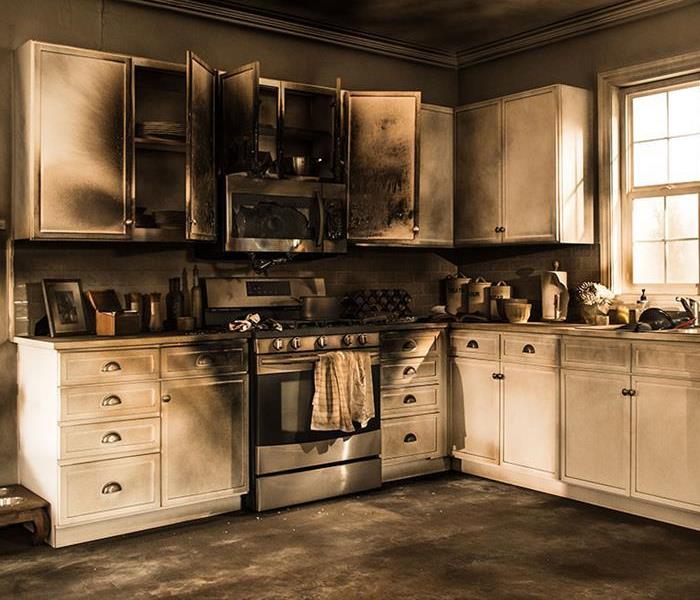 Fire Damage
Fire Damage
The most common types of fires that we have to clean up come from cooking, smoking, and electrical issues. However, there are many other reasons that can lead to fires This blog will focus on some of the uncommon fire we have had to clean up over the years.
Microwaves
Microwaves - especially out-of-date models - are one of the most common sources of house fires. Accidentally microwaving a piece of silverware or aluminum foil can cause arcing, and dry foods can easily ignite if cooked for too long. To make matters worse, the fan can also provide oxygen to feed the flames, which is why you should never leave a microwave unattended when in use.
Batteries
While battery-related fires are rare, they do happen. 9-volt batteries are especially hazardous, since the positive and negative posts are so close together. If a piece of conductive metal comes between those posts, it could cause a short, igniting any nearby combustible materials. The best option is to store unused batteries in their original packaging, or to cover the ends with a bit of electrical tape. Never store batteries in a drawer with loose metal or flammable objects.
Light Bulbs
All outlets are rated for a certain wattage, and use light bulbs that exceed those standards is a fire waiting to happen. If the outlet is unmarked, the safest course of action is to choose light bulbs that are 60 watts or below. If your home includes track or recessed lighting, consider using cooler LED bulbs instead of CFLs in order to avoid overheating.
Dryer Lint
Every year, more than 15,000 fires are caused by dryer lint. Lint traps do not catch the majority of lint, which means that most of it ends up in the dryer vents, blocking air flow and exhaust gasses and eventually becoming a serious fire hazard. Clean the lint trap between each load of laundry, and take the time to clear lint away from the vent and the back of the dryer at least once a month.
Laptops
Laptops heat up during regular use, and covering up their cooling vents can result in overheating and even a Springfield fire. Avoid leaving your laptop on the bed, couch, or any other surface that might block air flow.
Reading Materials
Newspapers, magazines, books, and paperwork can easily ignite if stored too close to a heat source. Always store reading materials on a shelf or in another cool, dry place, and consider tossing out anything that you won't use again so that it doesn't become a hazard in the future.
Heating Pads
Heating pads and electrical blankets that are old, damaged, or improperly used can pose a significant risk to your home and your safety. Replace any pads that have missing covers, tears, cracks, or exposed wires. Avoid bunching pads up during use, and never fall asleep with a heating pad turned on - many older models do not have an auto-off setting, which can lead to serious burns.
Charcoal
Barbecue charcoal is highly flammable, even when it's damp. The best way to store charcoal is to keep it inside a metal container with an air-tight lid, so that if a fire does start, it won't be able to spread. Keep charcoal in an area that isn't exposed to sunlight or moisture, such as a shed or outdoor storage unit.
Clutter
Assorted clutter is a surprisingly common source of household fires. Combustible materials that are stored near light fixtures or electrical outlets can easily ignite; clutter in the bedroom is especially dangerous since it gives you less time to react to a potential fire. Avoid stacking clothing or paperwork in a closet with light bulbs, and vacuum regularly so that flammable dust doesn't accumulate around sockets and light fixtures.
Old Appliances
Old and outdated appliances are a major fire hazard, even if appear to be functioning properly. Many older appliances do not have the built-in safety features that come with modern models, and pieces may wear out or break down over time with regular use. Check old appliances regularly for worn insulation, exposed wiring, or malfunctioning components.
Holiday Light Safety
11/22/2021 (Permalink)
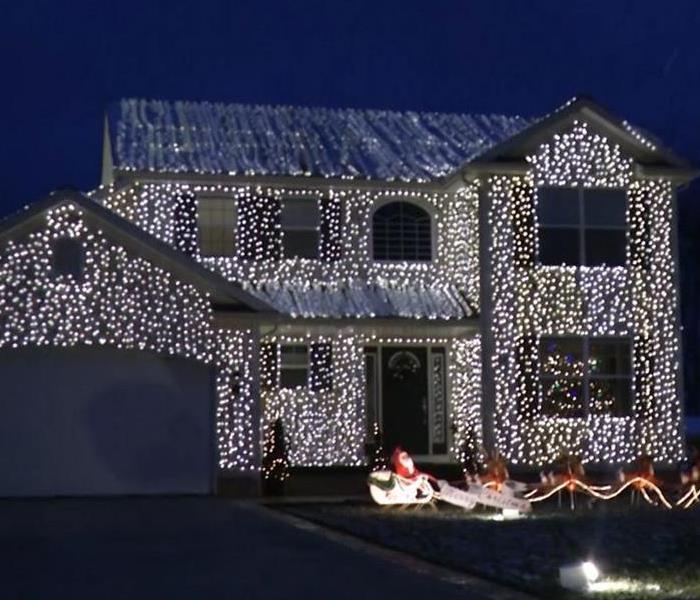 Holiday lights can make your house look great but can also increase the chance of having a fire
Holiday lights can make your house look great but can also increase the chance of having a fire
Holiday Light Safety
Christmas is upon us and holiday decorations are in full swing. For many home owners, decorating for Christmas is a tradition and something that is enjoyed by many. Whether you only decorate the interior of the home or you decorate both the interior and exterior, decorations and lights certainly add to the splendor of the Christmas season. According to the National Fire Protection Association fire departments responded to an average of 200 homes for structure fires related to Christmas trees between 2011-2015. Avoid Christmas tree and light related fires by following these simple safety tips.
Trees
When purchasing live Christmas trees, check for freshness and try to avoid dry trees. When you are cutting the tree, cut 1-2 inches from the base of the trunk to ensure optimal water absorption. Live trees require plenty of water. Make sure that you are checking the tree daily and watering when needed. If you prefer an artificial tree, ensure that the tag reads “Fire Resistant”. When placing the trees in your home, ensure that they are placed at least 3 feet away from all heat sources.
Lights
Check all lights to ensure that there are no worn or broken cords or loose bulbs. If you find any damage, dispose of the damaged lights and replace. When purchasing lights be sure to check the label that shows whether or not they are for indoor or outdoor use and purchase accordingly. In addition, read the instructions included with the lights. Most recommend that you plug no more than three strands together so that you are not overloading the socket. Last but not least, turn ALL Christmas lights off when going to bed or leaving the home.
If you find yourself with a damage this holiday season, call our office. Our teams will evaluate your damage and give you a clear explanation of the restoration process.
Common Causes For Fire Damage
11/19/2021 (Permalink)
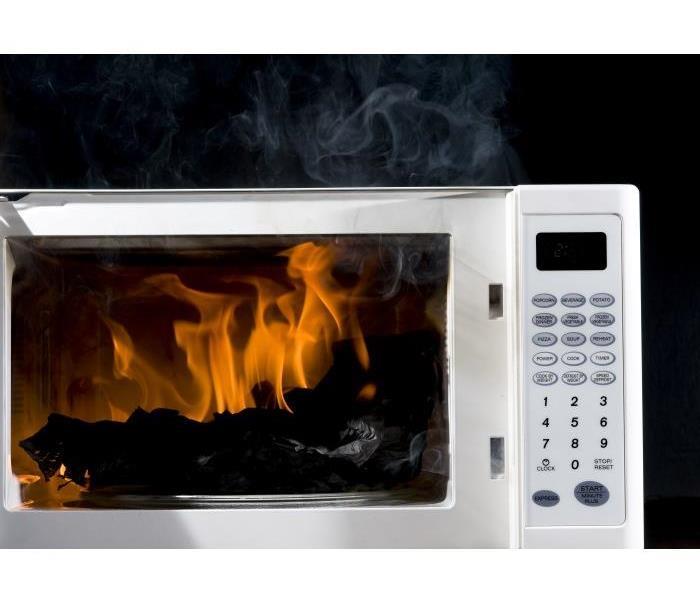 Microwaves are one of the many house hold items that can cause a fire
Microwaves are one of the many house hold items that can cause a fire
Most people are aware of the fire risks posed by candles, smoking, and malfunctioning appliances, but there are also a number of everyday household hazards that may surprise you. Below are some of the most commonly overlooked sources of house fires.
Microwaves
Microwaves - especially out-of-date models - are one of the most common sources of house fires. Accidentally microwaving a piece of silverware or aluminum foil can cause arcing, and dry foods can easily ignite if cooked for too long. To make matters worse, the fan can also provide oxygen to feed the flames, which is why you should never leave a microwave unattended when in use.
Batteries
While battery-related fires are rare, they do happen. 9-volt batteries are especially hazardous, since the positive and negative posts are so close together. If a piece of conductive metal comes between those posts, it could cause a short, igniting any nearby combustible materials. The best option is to store unused batteries in their original packaging, or to cover the ends with a bit of electrical tape. Never store batteries in a drawer with loose metal or flammable objects.
Light Bulbs
All outlets are rated for a certain wattage, and use light bulbs that exceed those standards is a fire waiting to happen. If the outlet is unmarked, the safest course of action is to choose light bulbs that are 60 watts or below. If your home includes track or recessed lighting, consider using cooler LED bulbs instead of CFLs in order to avoid overheating.
Dryer Lint
Every year, more than 15,000 fires are caused by dryer lint. Lint traps do not catch the majority of lint, which means that most of it ends up in the dryer vents, blocking air flow and exhaust gasses and eventually becoming a serious fire hazard. Clean the lint trap between each load of laundry, and take the time to clear lint away from the vent and the back of the dryer at least once a month.
Laptops
Laptops heat up during regular use, and covering up their cooling vents can result in overheating and even a fire. Avoid leaving your laptop on the bed, couch, or any other surface that might block air flow.
Reading Materials
Newspapers, magazines, books, and paperwork can easily ignite if stored too close to a heat source. Always store reading materials on a shelf or in another cool, dry place, and consider tossing out anything that you won't use again so that it doesn't become a hazard in the future.
Heating Pads
Heating pads and electrical blankets that are old, damaged, or improperly used can pose a significant risk to your home and your safety. Replace any pads that have missing covers, tears, cracks, or exposed wires. Avoid bunching pads up during use, and never fall asleep with a heating pad turned on - many older models do not have an auto-off setting, which can lead to serious burns, short-outs, and even fires.
Charcoal
Barbecue charcoal is highly flammable, even when it's damp. The best way to store charcoal is to keep it inside a metal container with an air-tight lid, so that if a fire does start, it won't be able to spread. Keep charcoal in an area that isn't exposed to sunlight or moisture, such as a shed or outdoor storage unit.
Clutter
Assorted clutter is a surprisingly common source of household fires. Combustible materials that are stored near light fixtures or electrical outlets can easily ignite; clutter in the bedroom is especially dangerous since it gives you less time to react to a potential fire. Avoid stacking clothing or paperwork in a closet with light bulbs, and vacuum regularly so that flammable dust doesn't accumulate around sockets and light fixtures.
Old Appliances
Old and outdated appliances are a major fire hazard, even if appear to be functioning properly. Many older appliances do not have the built-in safety features that come with modern models, and pieces may wear out or break down over time with regular use. Check old appliances regularly for worn insulation, exposed wiring, or malfunctioning components.
Winter Fire Damage
11/11/2021 (Permalink)
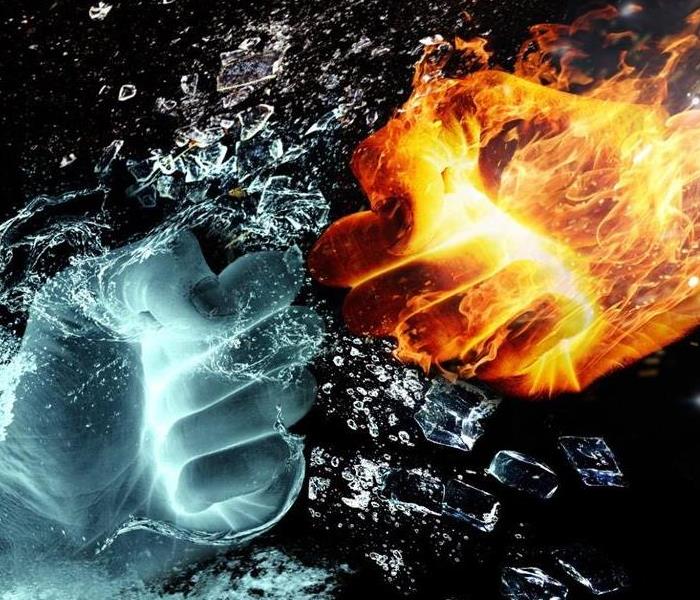 The chance of having a fire increases during the winter
The chance of having a fire increases during the winter
According to FEMA, home fires occur more in winter than in any other season.
In fact:
- Half of all home heating fires occur in the months of December, January & February.
- Heating equipment is involved in 1 in every 6 reported home fires & 1 in every 5 home fire deaths.
Here are some tips to avoid damage to your property this winter:
- Keep anything that can burn at least 3 feet away from any heat source like fireplaces, wood stoves, radiators or space heaters.
- Keep portable generators outside, away from windows and as far away as possible from your house.
- Install and test carbon monoxide alarms at least once a month.
- Have a qualified professional clean and inspect your chimney and vents every year.
- Store cooled ashes in a tightly covered metal container, and keep it outside at least 10 feet from your home and any nearby buildings.
- Plug only 1 heat-producing appliance (such as a space heater) into an electrical outlet at a time.
For more information on how to prevent winter fires, you can visit www.usfa.fema.gov/winter/
Fire Damages During The Holidays
11/2/2021 (Permalink)
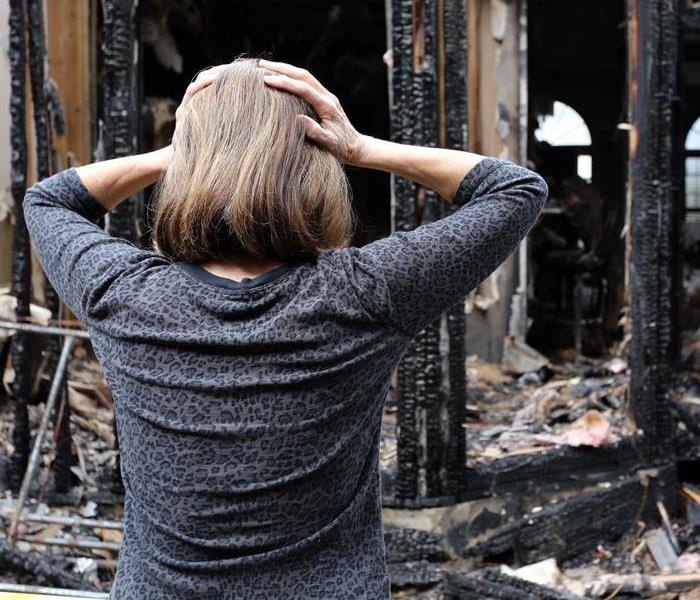 During Thanksgiving and Christmas the chances of you having a fire increases
During Thanksgiving and Christmas the chances of you having a fire increases
Most homeowners are aware holiday decorations should be used with care. Each year, statistics tell the story of the fire danger resulting from frayed wires, proximity to heat sources, and lights left on unattended. But disaster recovery specialists SERVPRO wants homeowners to know that the danger of fire caused by holiday decorating, and by Christmas trees specifically, actually increases after the holiday. Citing research from the National Fire Protection Association (NFPA)*, the fire and water damage experts at SERVPRO say while four out of five Christmas tree fires happen in December and January, the 10 days with the highest average number of fires were all after Christmas Day.
"For many families, preparing for the holiday season is a very busy time," said Sue Steen, SERVPRO Industries, Inc. chief executive officer. "Come December 26, it's tempting to relax and stop watering the Christmas tree, replacing bulbs in outdoor lights and tucking indoor garlands back into place. Dry greens, open sockets and decorations that slip dangerously close to light sockets or fireplaces can all increase the risk of fire in the days after the Christmas holiday."
The American Christmas Tree Association** quotes Nielsen research that says Americans purchased 21.6 million live Christmas trees in 2011. That number is significant because, according to the NFPA, Christmas trees remain the number one culprit in holiday fires. Forty-three percent of Christmas tree fires happen in December, but January is close behind, claiming 39 percent -- numbers that demonstrate the danger of allowing Christmas trees to dry out during and after the holiday season. Tragically, Christmas tree fires are particularly deadly, claiming on average one life in every 40 fires compared to an average of one death per 142 total reported home fires.
Steen encourages homeowners who choose to decorate with live Christmas trees to be diligent about watering their trees both before and after the holidays. "When a Christmas tree dries out, it takes only a single spark from the fireplace, a draft that blows a candle flame too near, or a carelessly held cigarette to turn your holiday celebration into a tragedy," says Steen. "Beyond the damage from the fire itself, a Christmas tree fire, like any fire, can result in extensive smoke and water damage throughout your home, and can even be deadly."
As the holiday season moves into full swing, SERVPRO reminds homeowners to take common sense precautions based on a clear understanding of the potential danger to help prevent holiday traditions from turning into a holiday nightmare.
Fire Damage Tips
10/13/2021 (Permalink)
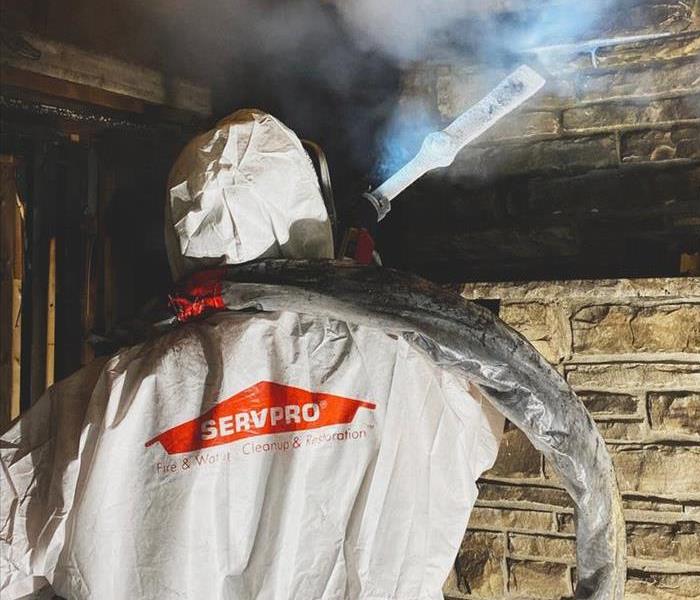 SERVPRO technicians are certified to clean up fire damage
SERVPRO technicians are certified to clean up fire damage
There is nothing worse then having your home or business affected by a fire. Its hard to imagine the damage that fires can cause, even the small ones. Its extremely important to understand the process of fire cleanup as well as the timetable of how long you will be out of your home business. This blog will focus on tips that will help you get through a fire damage if one ever occurs at your home or business.
1. Be Prepared. Your families safety is the most important aspect of a fire damage. Make sure you have prepared an escape plan and meeting point outside your house. This plan should be created now and practiced regularly. That why If a fire happens everyone will know all the exits and where to go once they get out of the house.
2. Track Your Contents. One of the most challenging aspects of cleaning up a fire is having an accurate list of contents that need to be replaced. This is very hard to do on the back end. Go ahead and make a list of all the valuable items in your home. This includes electronics, appliances, and decorations. This will not only help the mitigation process, but will also help you get reimbursed by insurance quicker.
3. Remove the Source. Once the cleanup process begins the first action should be removing whatever caused the damage. For example, if the fire originated from the kitchen oven its mandatory to get the oven out of the structure as as soon as possible. Getting the source out will immediately help with the odor.
4. Top Down Cleaning. Its important that the restoration company who is cleaning up the damage knows what they are doing. once the source is removed top down cleaning needs to take place. This means started from the ceiling and work your way all the way down to the floors. By doing this you will get rid of all the soot and not have to waste time by re cleaning certain areas.
Hopefully you never experience a fire damage. But if you do I hope this tips will make the process a little easier to deal with. Please don't hesitate to reach out if you ever have a fire at your property!
Different Odor Removal Techniques
2/2/2021 (Permalink)
If you have ever had a fire at your home or business you know the difficulties that come with it. One of the major issues that can linger for a long time after is the odor. Here at SERVPRO we have many different techniques for removing odors. This blog will spotlight on how we deal with unwanted odors.
Homeowners who wish to eliminate unpleasant smells from their home can often succeed in doing so by using some very basic odor removal techniques. Some of the most common sources of unpleasant smells include smoke from cigarettes or fires, and biological waste produced by pets. To some extent, basic cleaning methods can successfully neutralize these foreign agents from carpets and upholstery. Provided the contaminants are located, and have not soaked into materials completely, enzymatic cleaners and wet paper towels that can be bought in any retail store may possibly restore a fresh smell to the air. However, products that cover up odors with more pleasant smells offer only temporary relief from contaminants that have not been actually removed. Homeowners should be careful not to mistakenly purchase products that simply cover up bad smells. They must also be willing to contact professionals when their best efforts prove unsuccessful in completely clearing the offensive odors in a room.
The success of any odor removal project depends on properly identifying the contaminants producing the bad smell. Smoke and pet wastes are easily identified and often can be handled by individuals who apply determination and ingenuity to a home remedy cleaning project. However, other contaminants, ranging from sewer gas that creeps back up into pipes, and smells produced by decaying protein, food products, and various oil-based substances, are not only difficult to eliminate, they are also difficult to pinpoint. Professional carpet cleaners are trained, and often certified, in determining the nature of contamination first. Once the diagnosis has been made, specialized tools and procedures available only to properly trained technicians, that are most often certified, are then employed to purify the surfaces that have been affected.
While it is always good to apply basic odor removal techniques to whatever extent they can be successfully implemented, homeowners should also be willing to pay for professional cleaning in order to make sure that contaminants that produce bad smells have been correctly and thoroughly removed.
Smoke Odor Removal From Carpet and Upholstery
11/23/2020 (Permalink)
Seeking out professional help for smoke odor removal especially in the case of carpets and upholstery, is the first correct step in obtaining proper smell extraction. This ordeal can be very costly and time consuming for an individual to experiment with on their own, which is why many local professionals are available to help home owners who have suffered the unfortunate fate of this scenario.
First off, ascertaining the severity of the situation is one of the most important aspects in obtaining an accurate quote from a professional beforehand. Additionally, keeping a close watch on the amount of time that has elapsed since the smell had first entered the fibers will also dramatically change the amount of time and overall cost of the cleaning. If weeks have gone by without any professional aid, carpets and upholstery may become permanently damaged, suffering discoloration among other things.
Smoke odor removal professionals will first get rid of any residue that’s physically left on the surface of the fibers. The first actual deodorizing element to the process is to eliminate any sources of the smell, including any unsalvageable materials that cannot be processed properly and thus, must be disposed of. Next, a thorough cleaning of any salvageable surfaces will be imperative in further eliminating the smell and keeping it from reoccurring.
Since the smell is airborne in nature, professionals will need to create a type of fog that is comprised of cleaning agents and is pumped into the area to eliminate smells that fill the room. If it’s needed, items in the room may be sealed off and quarantined to avoid any exposure to the smell during the odor extraction.
Hydroxyl Generators
11/19/2020 (Permalink)
The main benefit of using a true hydroxyl generator is that they are safe to use in occupied areas for deodorization purposes. Insurance companies do not have to cover a homeowner’s hotels or meals. Business owners do not have to shut down and loose precious business.
If people and animals can be removed from the treatment area, ozone will always do the job faster. And the general rule of thumb is if a strong ozone generator would take one day to do a job, a true hydroxyl generator will take three to five days to do the same job. But insurance companies don’t seem to have a problem paying for the extra time it takes a hydroxyl generator to do the job because they are saving on hotel and food costs and their customers are much happier staying in their own homes and businesses. In saying this, hydroxyl generators are commonly one of the first pieces of equipment installed on the job and can be run the entire length of the job. These machines are already in Xactimate and bring in some $200 per day on a rental. With the price of the hydroxyl generators on the market, there would be a 100% return on investment within the first week of use.
These generators have been successfully tested on fires and other restoration and bio jobs, including protein fires, floods, dead body situations, skunk odors, pet urine odors, musty odors and many types of VOC odors. Many restoration contractors have converted existing deodorizing chambers or added their own hydroxyl rooms with great success. You can run a hydroxyl room 24 hours a day and enter the room at any time with no threat to your health. True hydroxyl generators also will not bleach wet fabrics so they can be run on damp carpet without fear of lightening the color.
However, it’s important to note that hydroxyl generators are not intended for use on mold remediation jobs where there is a large infestation on surfaces or behind walls. The established protocols should always be followed in these instances. But generators with good filtration are excellent for airborne microbial remediation where bacteria or fungi have become aerosolized.
Preventing Fires in the Winter
11/16/2020 (Permalink)
Prevent Fire Damage This Winter
Heat Your Home Safely
The winter season is here and with it comes shorter days and lower temperatures. In middle Tennessee, winter brings a change in the weather. In an effort to keep our homes and workplaces cozy, many people use alternative heat sources like fireplaces, portable space heaters, and wood burning stoves.
Did You Know?
According to the National Fire Protection Association:
- 50% of all residential heating-related fires are reported during the months of December, January, and February.
- Heating equipment is a leading cause of home fire deaths.
- Heating equipment fires cause an estimated $1 billion in direct property damage annually.
Keep the following safety tips in mind to help reduce your risk of a heating-related fire.
- Keep anything flammable at least three feet away from heating equipment, like the furnace, fireplace, wood stove, or a portable space heater. Have a three foot "kid free zone" around open fires and space heaters.
- Make sure the fireplace has a sturdy screen to stop sparks from flying into the room. Ashes should be cool before putting them in a metal container. Keep the container a safe distance away from your home.
- Remember to turn portable heaters off when leaving the room or going to bed.
- Always use the right kind of fuel, specified by the manufacturer, for fuel burning space heaters.
- Have heating equipment and chimneys cleaned and inspected every year by a qualified professional.
- Have a qualified professional install stationary space heating equipment, water heaters, or central heating equipment according to local codes and manufacturer's instructions.
- Test smoke alarms monthly.
If your property does suffer fire damage or smoke damage, contact SERVPRO of Sumner County at 615-822-0200 to help make it "Like it never even happened."
Fire Damage From Grilling
11/2/2020 (Permalink)
There's nothing like firing up the grill at your Dickson home during the summer months! Did you know, July is the peak month for grill fires? A backyard barbecue can become dangerous quickly if proper safety precautions aren't considered. SERVPRO of Cheatham, Robertson & Dickson Counties wants you to have an enjoyable and safe summer. Consider the following tips to help ensure your summer celebrations are disaster free!
- Propane and charcoal BBQ grills should only be used outdoors.
- The grill should be placed well away from the home, deck railings and out from under eaves and overhanging branches.
- Keep children and pets away from grill area.
- Keep your grill clean by removing grease or fat buildup from the grills and in trays below the grill.
- Never leave your grill unattended.
- When using a charcoal grill, let the coals completely cool before disposing in a metal container.
Tips and information provided by the National Fire Association.
Tips For Preventing Fires
10/9/2020 (Permalink)
As the temperature starts to drop we begin see an increase in fire damage. This blog will focus on ways to help prevent fires at your home or business. According to a 2018 study there were over 1.3 million properties that suffered a fire damage. This resulted in over 15,000 injuries and over 25 million dollars in repairs. By practicing these tips you can help prevent having a fire at your house.
-Check Smoke Detectors Regularly
When a fire initially starts a properly working smoke detector can not only save you money, but it could also save your life. It is recommended to test them monthly and frequently exchange the batteries. It only takes a few minutes to test them and its recommended to completely replace the detectors once every ten years. If your house has more then one floor its best to have detectors on each level and especially one close to each sleeping area.
-Watch Your Appliances
Stoves, washing machines, and microwaves all make our lives easier. However, when not used properly they can easily start a fire. Its recommended to clean these appliances regularly and not to use them when nobody is present.
-Be Extra Safe in The Kitchen
Recent studies have show that over half of house fires start in the kitchen. It’s important make sure you keep a fire extinguisher in close reach of the kitchen. Grease fires are most common in this area. It’s important to know that you must treat a grease fire differently than a regular fire. Never use water to put out a grease fire. Instead try to cover the fire with a heavy metal lid or dump baking soda directly on it.
-Don’t Smoke Inside
We don’t recommend smoking period. However, if you do please step outside and dispose your cigarette butts in a safe place.
-Have A Plan
Even if you follow all these tips there is still a chance your home could experience a fire. It’s smart to have an emergency plan in place. If you don’t already one the best time to make one is now. Choose a safe meeting place outside your house. Establish escape routes from every room of your house. Finally make sure everyone in your home knows where the fire extinguishers are and how to use them properly.
Fire Extinguisher Safety in Sumner County
2/28/2020 (Permalink)
All of us at SERVPRO® of Sumner County hope you never have a fire. If the worst happens, we are experts in cleaning the damage left by smoke and fire in your home or office.
Fire extinguishers may help prevent fire damage or smoke damage, but only if you know how to use them.
SERVPRO® of Sumner County wants to share these tips from FEMA. You can try to fight a small fire only if:
- You have alerted others in the building that there is a fire
- Someone has called the fire department
- You are physically able to use a fire extinguisher
- The fire is small and contained (like a wastebasket)
- You are safe from the fire’s smoke
- You have a clear escape route
How to Use a Fire Extinguisher: SERVPRO® of Sumner County suggests you remember PASS:
Pull the pin. Hold the extinguisher with the nozzle pointing away from you and release the locking mechanism.
Aim at the base of the fire.
Squeeze the lever slowly and evenly.
Sweep the nozzle side to side.
If you see a small fire at your place of business or home, and you think you can take care of it yourself, use these tips above. If you have any worries, you and everyone should leave the building and call 9-1-1 when you are safe, outside.
Christmas Tree Safety
11/29/2019 (Permalink)
Christmas is right around the corner and for many people decorating is about to be in full swing. Holidays are a busy and joyous time of the year, here are some Christmas tree facts and safety tips for you and your family.
- More than one of every four home Christmas tree fires is caused by electrical problems.
- A heat source too close to the tree causes one in every four fires.
Together those statistics account for TWO IN EVERY FOUR fires. Don’t be a statistic. Follow these tips to keep you and your family safe during the holidays.
Picking The Tree
Choose a tree with fresh, green needles that do not fall off when touched.
Placing The Tree
Before placing the tree in the stand, cut 2” from the base of the trunk.
Make sure the tree is at least three feet away from any heat source, like fire pits, radiators, candles, heat vents or lights.
Make sure the tree is not blocking an exit.
Add water to the tree stand daily.
Lighting The Tree
Use lights that have the label of a recognized testing laboratory. Some lights are only for indoor or outdoor use.
Replace any string of lights with worn or broken cords or loose bulb connections. Read manufacturer’s instructions for number of light strands to connect.
Never use lit candles to decorate the tree.
Always turn off Christmas tree lights before leaving home or going to bed.
Get rid of the tree after Christmas or when it is dry. Dried-out trees are a fire danger and should not be left in the home or garage, or placed outside against the home. You can check with your community to see if there is a local recycling program.
Chimney Checklist
11/20/2019 (Permalink)
The cold winter months are upon us and curling up by a nice cozy fire might be in the near future for many. Before you go gather wood and building a fire make sure to follow this checklist to ensure that your fireplace is safe for use.
Chimney Checklist (Say that 10 times fast)
Inspection-
It is recommended that all homeowners have their chimneys inspected annually by a certified chimney sweep. Having your chimney inspected will ensure that there are not potential health and safety hazards.
Chimney Cap-
Always inspect your chimney cap. If your chimney cap has been damaged it can allow moisture, animals and debris to enter your flue.
Check Flashing-
If the flashing around the chimney appears to be warped or bent it could be allowing moisture and water to enter the chimney. Long term damage caused by this could include deterioration and leakage.
Trim Tree Branches-
Ensure that there are no tree branches that could potentially damage the chimney during a storm and/or cause a fire.
Repair Missing Bricks, Chipped Bricks and Mortar-
Find them. Fix them. J
Clean the Flue-
Creosote is accumulated by burning fires and is the leading cause of chimney fires. Having your chimney inspected and cleaning should eliminate any creosote buildup.
Remove Leftover Ash-
A thin layer of ash can assist with starting a fire, but a large amount of ash will choke your fire out from the moisture content.
Test Damper-
Make sure that the damper is in good working order and form a tight seal when shut. If the damper doesn’t close properly and form a tight seal it will allow outside air to mix with heated air and increase your energy cost significantly.
Install Batteries in Smoke Alarms/Detectors-
If you aren’t changing the batteries in your smoke detector out during daylight savings time, make sure that they are changed before beginning to build fires.
Store Firewood-
Be sure to store your fire wood in a ventilated area, off of the ground and away from exposure to water or moisture.
Stay warm friends! Call our office if you have any questions.
Holiday Fire Safety
11/14/2019 (Permalink)
Did you know that holidays bring more than joy with them each year? They also bring a greater risk for fire. Make sure that you and your family are following some simple tips to ensure that you have a SAFE and HAPPY holiday this year.
Holiday Entertaining
-Keep children and pets away from lit candles.
-Keep lighters and matches up in high locked cabinet.
-Test you smoke alarms and advise guest of all exits and your home fire escape plan. If you need assistance in creating a plan you can go here.
-Stay in the kitchen when cooking and baking.
-Provide large deep ashtrays for smokers and ask smokers to keep their materials with them so that children can’t get them.
Holiday Decorating
-Some lights are intended only for indoor OR outdoor use, but not both.
-Keep lit candles away from decorations and other things that can burn.
-Use clips and NOT nails to secure lights and cords. This ensures that the cord will not be damaged.
-Choose decorations that are flame resistant OR flame retardant.
-Replace lights or decorations that have broken cords or loose bulb connections.
-Read manufacturer instructions for the proper number of lights that can be connected.
-Keep decorations away from windows and doors.
Before Heading To Bed Or Leaving The House
-BLOW OUT lit candles
-TURN OFF light strings
More than 1/3 of home decoration fires are started by candles and more than 2 of every 5 decoration fires happen because decorations are placed too close to a heat source. If you find yourself in need of our services over the holidays call our office. We are here to help.
Turkey Fryer Safety
11/6/2019 (Permalink)
With Thanksgiving rapidly approaching I’m sure that there are many people beginning to plan their Thanksgiving menu. In the South we like to fry turkeys to enjoy with our families during Thanksgiving dinner. Here at SERVPRO® of Sumner County we want you to be able to attend your Thanksgiving dinner and provide a beautiful fried turkey in the process. We have listed some tips below to ensure that you are frying your turkey safely.
Turkey Frying Safety Tips:
- Keep outdoor fryers off of decks, away from houses and vegetation and out of garages.
- Watch the weather. You never want to operate your fryer in the rain or snow.
- Make sure that the turkey is completely thawed. When ice mixes with hot oil it causes combustion and will create a large flame.
- Ensure that the fryer is placed on a solid surface.
- Never leave a fryer unattended.
- Leave at least 2 feet between the tank and burner when using a propane powered fryer.
- Follow the manufacturer’s instructions on how to properly fill the fryer with the correct amount of oil. Overfilling can cause the oil to ignite.
- Choose a smaller bird for frying. An 8-10 lb. turkey is best.
- Purchase a fryer with temperature controls, watch the oil temperature carefully. If the fryer becomes too hot it will smoke and can catch fire at a certain point.
- Wear googles to protect your eyes, gloves to protect your hands and keep a hose nearby in case of a fire.
- Skip the stuffing when deep frying a turkey and avoid water based marinades.
- Keep children and pets away from the fryer at all times.
- Once finished, carefully remove the pot from the burner. Let the oil cool overnight before disposing.
- Opt for an oil-less fryer. This uses infrared heat, rather than oil to cook the turkey.
Happy frying!!!
Wildfires
11/4/2019 (Permalink)
Wildfires happen quickly and are unpredictable at the very least. Here are some tips to help if wildfires become a threat in your area.
Measures to Prevent Wildfires In and Around Your Home
-Clear leaves and debris from around your home and your gutters.
-Screen in or create a barrier underneath decks and porches to aid in preventing combustible materials to accumulate.
-Remove dead vegetation from around your home or structure.
-Keep your lawn maintained and well hydrated. Cut any dead grass down as low as possible.
-Ensure that your trees are maintained, pruned and topped.
-Dispose of any debris or lawn clippings as quickly as you can after they accumulate.
-Inspect shingles and/or roof tiles and make any necessary repairs.
Emergency Plan
-Create an emergency supply kit and keep it in a safe place. Remember to include any important documents, medication lists, phone numbers, etc.
-Plan two separate routes out of your neighborhood and choose a designated meeting place for your family.
-Create an emergency evacuation plan and practice that plan with your family to ensure that everyone is aware of what it includes.
Community
-Contact your local city offices to check if your home is located in a high risk area.
-If you are a part of a homeowners association make sure to go over a plan to assist with shut ins or families with disabilities. Any assistance that friends and neighbors can provide is crucial to ensure everyone’s safety.
-Speak with your local fire department and ask them what their plan is in case of wildfires.
If you have any questions, would like more information or need assistance with fire/smoke damage in your home call our office today.
Not Every Hero Wears a Cape! Plan and Practice your Escape.
10/11/2019 (Permalink)
The National Fire Protection Association (NFPA) set this years campaign for fire prevention month as“Not Every Hero Wears a Cape! Plan and Practice Your Escape.”
Fire Prevention Month raises awareness about fire safety and home safety to help ensure your home and family are prepared in the case of an emergency. This is a perfect time to discuss fire safety with your family. It is important to discuss what to do in case of a fire with your family, including those who live outside of your household such as elderly family members. Here are some key points to discuss with your loved ones.
-In a typical home fire, you may have as little as one to two minutes to escape safely from the time the smoke alarm sounds. Planning and practicing an escape plan is crucial in preparing in case of an emergency.
-Check your smoke alarms monthly to ensure that they are in proper working order and change the batteries out twice a year. Many find changing the batteries during daylight savings time to be easiest to remember.
-Practice makes perfect! Run through your families fire drill together. Have everyone go to a different room in the house and wait to set the alarm off. Practice the drill until all family members have executed the drill as planned and are safely in your meeting area outside of the home.
By preparing for a fire ahead of time, you can have peace of mind knowing family and your home will remain safe year round.
Call our office or your local fire department if you need assistance in checking the fire alarms in your home.
SERVPRO® of Sumner County - Fire Extinguisher Tips
12/7/2018 (Permalink)
SERVPRO® of Sumner County knows that the proper use of fire extinguishers can prevent fire damages and injuries from destroying lives.
Fire extinguishers effectively put out 80% of all fires. Homes and businesses alike should have fire extinguishers on hand and ready at all times. At this time, there is not a law stating that a propery owner must install fire extinguishers in their homes, businesses with 5 or more employees are required by the Occupational Safety and Heath Administration (OSHA) to maintain fire extinguishers in their facilities. Businesses are required to have one fire extinguisher every 3,000 square feet, and are required to train employees how and when to use fire extinguishers. Training must be provided to new employees, as well as maintained once yearly.
OSHA requires all fire extinguishers to be inspected visually each month, as well as an annuall maintenance check on each fire extinguisher. Fore extinguishers are to be placed where they cannot be moved or damaged and the carrying handle should be 3 ½ to 5 feet above the floor.
Questions to Ask Yourself About Using a Fire Extinguisher:
- Have I pulled the fire alarm?
- Is the fire extinguisher easy to reach?
- Do I know how to use it? [Look up PASS here]
- Is the fire contained in a small area?
- Is the smoke non-toxic?
- Can everyone get out?
- Do I have an escape route?
If you can answer “yes” to all of the questions, it is reasonable to use the fire extinguisher.
SERVPRO® of Sumner County reminds you that fire moves and builds at a rapid pace. If you cannot contain it within 30 seconds, get everyone out of the area, and call 9-1-1 once you are outside.
Smoke and Soot Damage Can Cause a Pervasive Odor in Your Sumner County Home.
11/16/2018 (Permalink)
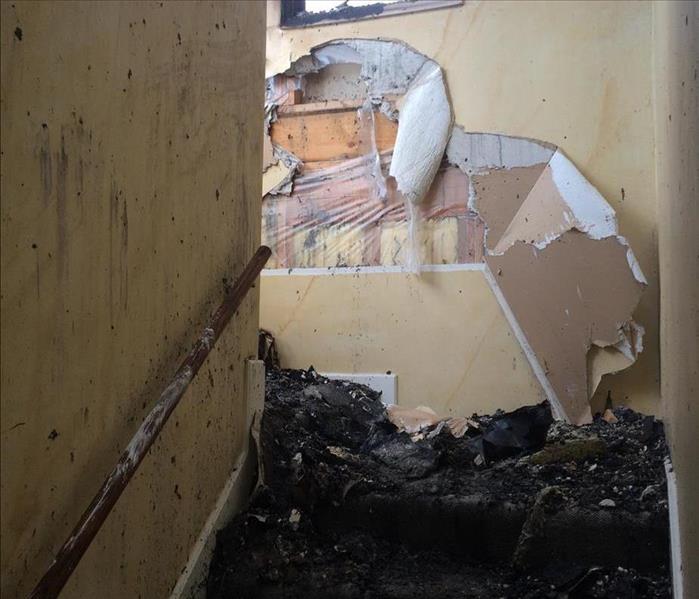 Have Questions about Fire, Smoke or Soot Damage?
Call Us Today 615-822-0200
Have Questions about Fire, Smoke or Soot Damage?
Call Us Today 615-822-0200
Smoke and soot is very invasive and can penetrate various cavities within your home, causing hidden damage and odor. Our smoke damage expertise and experience allows us to inspect and accurately assess the extent of the damage to develop a comprehensive plan of action.
Smoke and soot facts:
Hot smokes migrates to cooler areas and upper levels of a structure.
Smoke flows around plumbing systems, seeping through the holes used by pipes to go from floor to floor.
The type of smoke may greatly affect the restoration process.
Different Types of Smoke
There are two different types of smoke-wet and dry. As a result, there are different types of soot residue after a fire. Before restoration begins, SERVPRO of Sumner County will test the soot to determine which type of smoke damage occurred. The cleaning procedures will then be based on the information identified during pretesting. Here is some additional information:
Wet Smoke – Plastic and Rubber
Low heat. Smoldering, pungent odor, sticky, smeary. Smoke webs are more difficult to clean.
Dry Smoke – Paper and Wood
Fast burning, high temperatures, heat rises therefore smoke rises.
Protein Fire Residue – Produced by evaporation of material rather than from a fire
Virtually invisible, discolors paints and varnishes, extreme pungent odor.
Our Fire Damage Restoration Services
Since each smoke and fire damage situation is a little different, each one requires a unique solution tailored for the specific conditions. We have the equipment, expertise and experience to restore your fire and smoke damage. We will also treat your family with empathy and respect and your property with care.
Have Questions about Fire, Smoke or Soot Damage?
Call Us Today 615-822-0200
Before The Feast
11/8/2018 (Permalink)
Each November, families gather to celebrate Thanksgiving by preparing a delicious feast, but if you don’t practice safe cooking habits, your happy holiday could become hazardous very quickly.
According to the National Fire Protection Association, cooking is the main cause for home fires and injuries, with Thanksgiving being the peak day for cooking-related fires. Review the following safety tips to ensure you can enjoy a safe holiday.
- Never leave cooking food unattended-stay in the kitchen when frying, grilling or broiling food. If someone must leave the kitchen for even a short period of time, they should turn off the stove.
- Check food regularly while cooking and remain in the home while cooking. Use a timer as a reminder that the stove or oven is on.
- Keep the kids away from the cooking area. Enforce a “kid-free zone” and make them stay at least three feet away from the stove.
- Keep anything flammable-pot holders, oven mitts, wooden utensils, paper or plastic bags, food packaging and towels or curtains—away from the stove, oven or any other appliance in the kitchen that generates heat.
- Do not wear loose clothing or dangling sleeves while cooking.
- Clean cooking surfaces on a regular basis to prevent grease buildup.
- Purchase a fire extinguisher to keep in the kitchen, Contact the local fire department for training on the proper use of extinguishers.
- Always check the kitchen before going to bed or leaving the home to ensure that all stoves, ovens and small appliances are turned off.
- Install a smoke alarm near the kitchen, on each level of the home, near sleeping areas and inside and outside bedrooms. Use the test button to check it each month. Replace all batteries at least once a year.
SERVPRO® of Sumner County wishes you a safe and happy holiday season.
Cooking This Holiday Season
10/24/2018 (Permalink)
Did you know cooking equipment is the leading cause of residential fires? As the holidays begin, fire precautions should as well.
A property owner experiences a flood of emotions when a fire ravages their business or home. Fear, uncertainty, stress and doubt about the future of the property scan be overwhelming to the property owner long after the flames have been extinguished and the smoke has cleared.
After the first wave of heroes have rescued the property, let SERVPRO® of Sumner County help restore your property. Combining rapid response, the utmost professionalism and open communication, we strive to restore not only the home or business, but to restore the customer’s peace of mind as well.
The National Fire Protection Association (NFPA) offers the following eye-opening statistics on fires:
- 475,500 structure fires were reported in the United States in 2016.
- These fires caused $7.9 billion in property damages.
- One structure fire was reported every 66 seconds.
If the unthinkable happens and a fire strikes, give our experts at SERVPRO® of Sumner County a call. We’ll help make it “Like it never even happened.”
Family Fire Escape Plans
10/12/2018 (Permalink)
SERVPRO® of Sumner County hopes you will never need your home or business to recover from fire or smoke damage.
Portable fire extinguishers may not be enough to save your home. Sometimes, the only option you have to keep yourself and loved ones safe is to escape. A small flame can turn into a large fire in a matter of minutes. Lives are more important than objects, so get yourselves and others out of danger.
SERVPRO® of Sumner County - Tips for Escape:
- Make an escape plan ahead of time and make sure everyone knows the plan.
- Make sure that all doors and windows open easily.
- Plan at least two different ways of escaping every room.
- When you leave, close the doors and windows to shut in the flames.
- Do not stop to pick up valuables, objects can be replaced you can not.
- Make sure your plan includes a place to meet that is a safe distance from the home.
- Do not turn off smoke alarms when you cook, you may need the warning.
- If you have to go through a smoke filled area to escape, cover your nose and mouth with something and crawl on the floor.
- Practice the plan until your entire family or business feels comfortable.
- Periodically go over the plan that is put in place to refresh everyones memory or make changes.
Fires are Preventable
10/10/2018 (Permalink)
When it comes to your Sumner County home, there are certain safety precautions that can be taken to help prevent fires. Ready.gov shares the following tips on home fire prevention.
Electrical and Appliance Safety
- Frayed wires can cause fires. Replace all worn, old damaged appliance cords immediately and do not run cords under rugs or furniture.
- If an appliance has a three-prong plug, use it only in a three-slot outlet. Never force it into a two slot outlet or extension cord.
- Immediately shut off, then professionally replace, light switches that are hot to the touch and lights that flicker.
Fireplaces and Wood Stoves
- Inspect and clean wood stoves pipes and chimneys annually and check monthly for damage or obstructions.
- Use a fireplace screen heavy enough to stop rolling logs and big enough to cover the entire opening of the fireplace to catch flying sparks.
- Make sure the fire is completely out before leaving the house or going to bed.
If you find yourself with fire damage to your Sumner County home call our office at 615-822-0200.
October is Fire Prevention Month-Make Sure You Have a Plan for Your Sumner County Home
10/3/2018 (Permalink)
October is Fire Prevention Month – a perfect time to examine emergency preparedness plans for your home and business, including your fire escape plan. Do you have a fire escape plan? Have you changed your smoke alarm batteries within the last year?
The National Fire Protection Association (NFPA) designates a week each October to focus on fire prevention awareness. The 2018 theme is
“Look. Listen. Learn. Be aware. Fire can happen anywhere.™)
This theme hopes to create awareness in the steps necessary to reduce the chance of a fire and how to react in the event a fire does happen. The NFPA states the following:
“LOOK” for places fire could start. Take a good look around your home. Identify potential fire hazards and take care of them.
“LISTEN” for the sound of the smoke alarm. You could have only minutes to escape safely once the smoke alarm sounds. Go to your outside meeting place, which should be a safe distance from the home and where everyone should know to meet.
“LEARN” two ways out of every room and make sure all doors and windows leading outside open easily and are free of clutter.
Stay safe and prepare now to help ensure you are ready for any disaster.
SERVPRO of Sumner County - Fire Restoration Process Overview
8/24/2018 (Permalink)
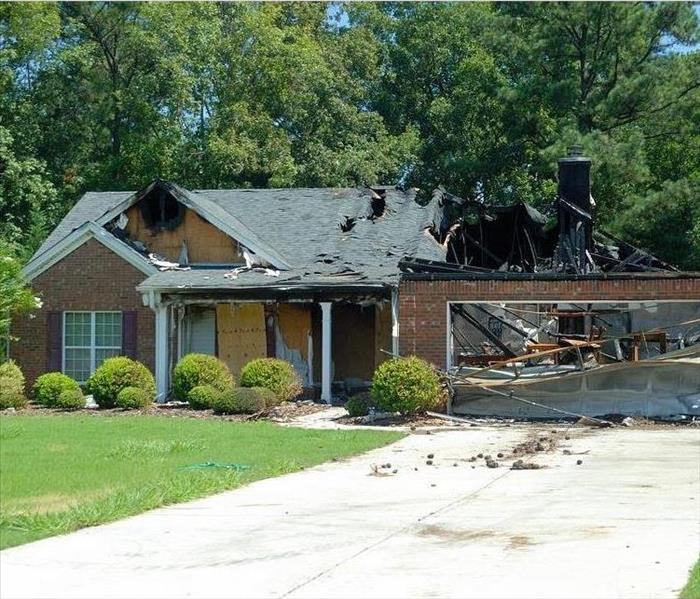 If you are ever in need of fire, smoke or soot damage services call our SERVPRO of Sumner County office at 615-822-0200.
If you are ever in need of fire, smoke or soot damage services call our SERVPRO of Sumner County office at 615-822-0200.
Here at SERVPRO of Sumner County we strive to provide excellent communication and prompt service to our customers. When we receive notification of damage to a customer’s home we understand that they are most times distressed and unsure of the mitigation process that is about to unfold. Below is a bird’s eye view of the process that we follow for fire damages.
One Hour:
Within one hour from notice of loss; SERVPRO of Sumner County will contact you to arrange for service. During this call our trained office staff will ask important questions regarding your damage, insurance information and any additional contact information that is needed.
Four Hours:
Within four hours of loss notification; SERVPRO of Sumner County trained technicians will be on-site to start mitigation services. The key to reducing damage and saving money is responding quickly to your damage.
Detailed Explanation:
A trained, uniformed and equipped SERVPRO of Sumner County professional will walk you through the job process step-by-step, explaining what to expect and the anticipated outcome. All damages are different and our on-site personnel will ensure that you are aware of each aspect of your damage.
Pretesting:
A SERVPRO of Sumner County professional will begin pretesting for restorability, working from the source of the damage outward. Different types of surfaces throughout the structure will need to be cleaned differently based on texture and proximity to the source.
Eight Hours:
Within eight business hours of on-site arrival, a verbal briefing of the scope will be communicated to the appropriate individual, most times your insurance adjuster or property manager.
Cleaning, Restoration & Deodorization:
SERVPRO of Sumner County will work neatly and efficiently to help your regain control of your property when a damaging event has occurred. Our certified teams will use state-of-the-art restoration techniques to ensure that your property is taken care right the first time.
Final Walk-Through:
After the work has been completed, a final walk-through will be conducted with you to help ensure your satisfaction.
If you are ever in need of fire, smoke or soot damage services call our SERVPRO of Sumner County office at 615-822-0200.
Holiday Light Safety
12/13/2017 (Permalink)
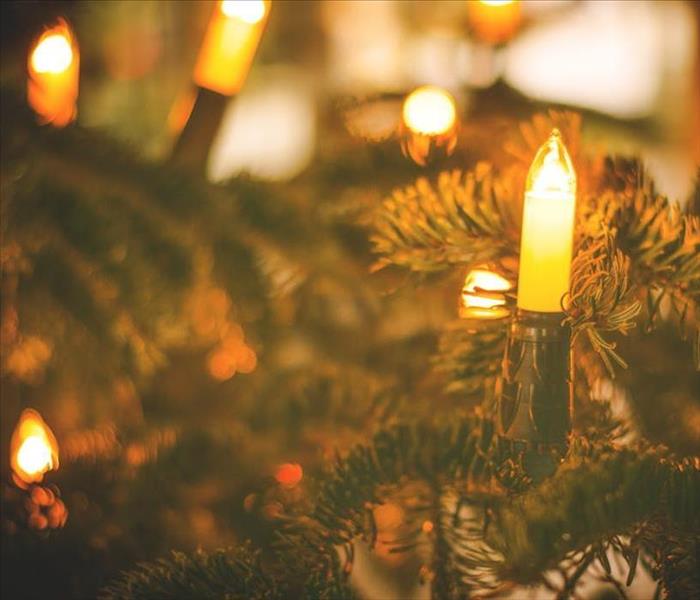 Check all lights to ensure that there are no worn or broken cords or loose bulbs.
Check all lights to ensure that there are no worn or broken cords or loose bulbs.
Holiday Light Safety
Christmas is upon us and holiday decorations are in full swing. For many home owners, decorating for Christmas is a tradition and something that is enjoyed by many. Whether you only decorate the interior of the home or you decorate both the interior and exterior, decorations and lights certainly add to the splendor of the Christmas season. According to the National Fire Protection Association fire departments responded to an average of 200 homes for structure fires related to Christmas trees between 2011-2015. Avoid Christmas tree and light related fires by following these simple safety tips.
Trees
When purchasing live Christmas trees, check for freshness and try to avoid dry trees. When you are cutting the tree, cut 1-2 inches from the base of the trunk to ensure optimal water absorption. Live trees require plenty of water. Make sure that you are checking the tree daily and watering when needed. If you prefer an artificial tree, ensure that the tag reads “Fire Resistant”. When placing the trees in your home, ensure that they are placed at least 3 feet away from all heat sources.
Lights
Check all lights to ensure that there are no worn or broken cords or loose bulbs. If you find any damage, dispose of the damaged lights and replace. When purchasing lights be sure to check the label that shows whether or not they are for indoor or outdoor use and purchase accordingly. In addition, read the instructions included with the lights. Most recommend that you plug no more than three strands together so that you are not overloading the socket. Last but not least, turn ALL Christmas lights off when going to bed or leaving the home.
If you find yourself with a damage this holiday season, call our office. Our teams will evaluate your damage and give you a clear explanation of the restoration process.
Understanding Content Coverage
11/8/2017 (Permalink)
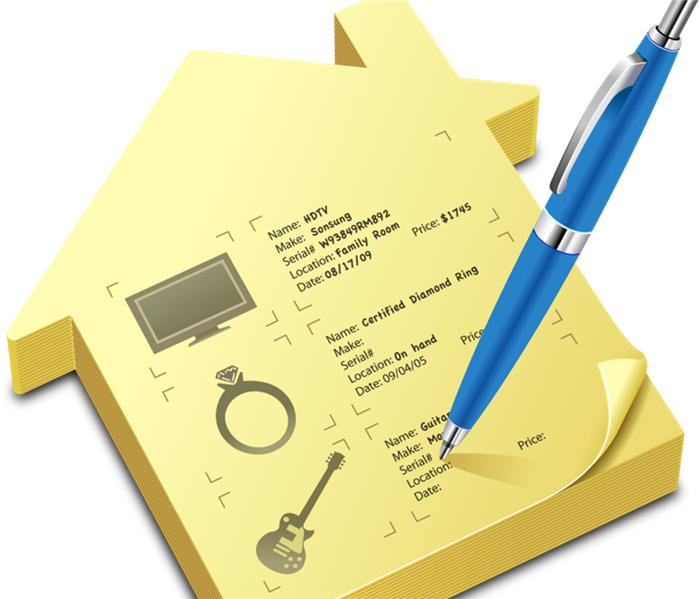 The best way to determine if you have enough content coverage is to conduct a home inventory.
The best way to determine if you have enough content coverage is to conduct a home inventory.
Understanding Content Coverage
Everyone has homeowners insurance right? It’s one of those things you have and hope you never have to use right? So, what happens if you do have to utilize coverage because of a damage?
Unfortunately, because homeowners insurance is necessary many homeowners rely solely on their agents to choose a policy that is right for them. This is totally fine, and works in many cases, but being educated on what your policy includes and doesn’t include is important.
Most policies are written and cover to repair or rebuild your home after damage. But what about ALL of the personal belongings inside of your home? Generally, your content coverage is 50 to 70 percent of the coverage that you carry on the structure of your home. In most cases this is a sufficient amount to cover personal items that are damaged, but in some cases it isn’t.
The best way to determine if you have enough content coverage is to conduct a home inventory. This is a much easier task thanks to modern technology. Walk through your home room by room and photograph all personal belongings. (TIP-If you picked your home up and turned it upside down, all items that would fall out are considered contents.) Open drawers and closets to photograph all items inside. You can catalog these items and keep them at an offsite location or you can download an app such as DreamVault and access it from any mobile device. This particular app is designed to house photos and information pertaining to each individual item, such as price, model and serial number. There is also a speech to text feature to help with documentation.
If you have jewelry, collector’s items, art or firearms, sometimes your coverage can fall short. Keep that in mind when documenting all items and reviewing your policy. If you find that your coverage is lacking you can generally purchase additional coverage or a rider for certain items.
When you have had damage to your home and personal belongings, you don’t want to worry with the added stress of insufficient coverage. Ensure that you are covered.
If you have damage to your home and/or personal items we are here to help. Call our office and we will walk you through the process and make your damage “Like it never even happened”.
Three Common Reasons For House Fires In Your Sumner County Home
9/25/2017 (Permalink)
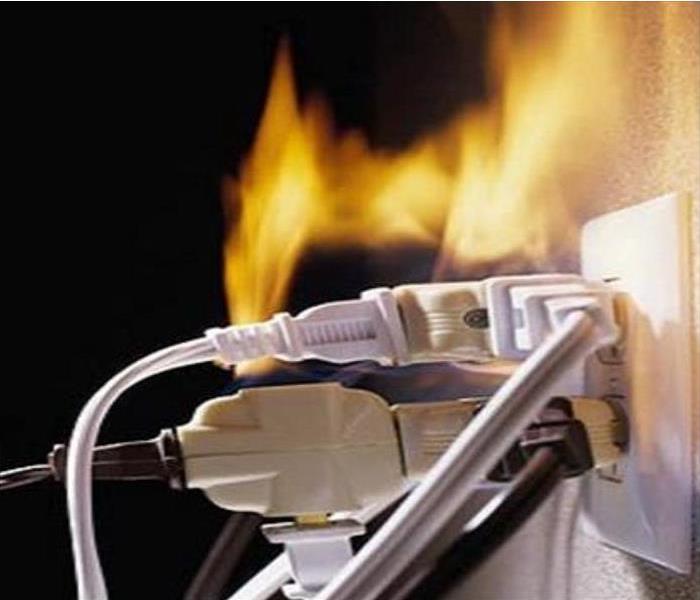 Educating yourself on the leading causes for house fires and prevention is a step in the right direction to ensure that your family and home are safe.
Educating yourself on the leading causes for house fires and prevention is a step in the right direction to ensure that your family and home are safe.
Three Common Reasons For House Fires In Your Sumner County Home
If a fire starts in your home you may have as little as two minutes to escape. House fires can be devastating and the road to recovery is long and hard. Educating yourself on the leading causes for house fires and prevention is a step in the right direction to ensure that your family and home are safe.
Electrical Outlets
Many electrical fires in homes or businesses are caused by faulty electrical outlets, old wiring, outdated appliances or electrical cords that are frayed.
-If you live in an older home have an electrician complete an inspection. Standards and codes are constantly being revised and updated to ensure safety.
-Do not overload your circuits.
-Understand the difference between surge protectors and power strips. Both devices allow you to plug in multiple electronics, but only the surge protector will help protect your electronics from a power surge.
Kitchen Fires
Carelessness in the kitchen can lead to devastating house fires. The leading cause of kitchen fires is due to unattended cooking. It’s important to be alert to prevent cooking fires.
-Never leave pots or pans unattended on your stove.
-Keeping your stove an oven clean will prevent buildup of food splatter and grease that could later ignite when the stove or oven is turned on for cooking.
-Keep any items that could ignite away from your stove top
-Ensure that you have a fire extinguisher in your kitchen in case of emergency.
Dryers
Dryer vents are becoming a much bigger and more common safety problem. Over time, your dryer vent fills with lint that sneaks by your dryers filter. Fires can occur when the excess lint builds up in the dryer or exhaust duct.
-Clean out the dryer vent regularly.
-Clean the lint filter after EACH load of laundry that is dried.
-Clean underneath and behind your dryer to eliminate any lint that collects.
Fire Damage-The Breakdown Of Damage
6/14/2017 (Permalink)
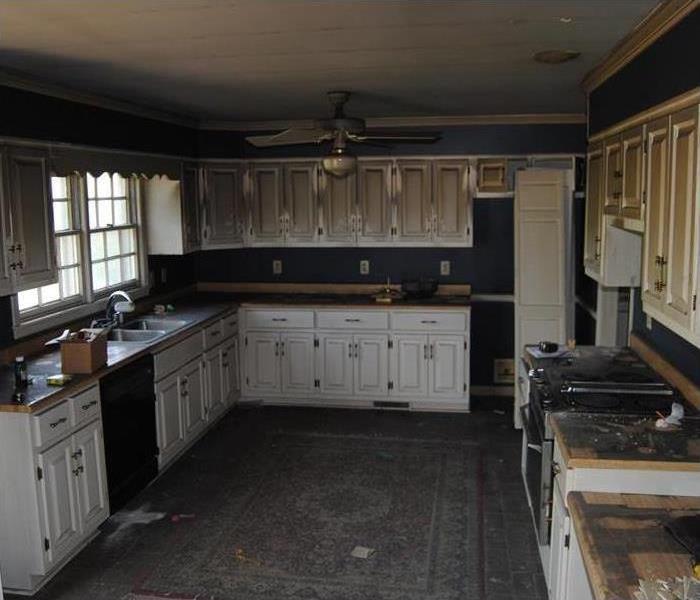 Understanding the effects of fire and how quickly items need to be evaluated and attended to can minimize the need for costly repair.
Understanding the effects of fire and how quickly items need to be evaluated and attended to can minimize the need for costly repair.
Fire Damage-The Breakdown Of Damage
There are roughly 300,000 to 400,000 residential home fires per year in the United States. These fires range from small to large and originate inside of the home. Fires are a devastating occurrence for homeowners and are extremely hard to overcome, as they take months to clean and repair. SERVPRO of Sumner County specializes in fire damage restoration and is here to help if you find yourself in need.
Damage to your structure and contents happen rapidly after the fire occurs. Every second counts after the fire is extinguished and our professionals know that damages increase and cost escalates the longer neutralization, corrosion control and cleaning is delayed. When restoration is prolonged, effects brought on by smoke exposure are extended. Below is a breakdown of the damage and effects from fire and smoke on a home.
Within Minutes:
Acid soot residues cause plastics to yellow; small appliances located close to the source of combustion discolor; highly porous materials (marble, alabaster) discolor permanently.
Within Hours:
Acid residues stain grout in bathrooms; fiberglass bath fixtures may yellow; uncoated metals tarnish, countertops may yellow; finishes on appliances, particularly refrigerators, may yellow; furniture finishes may discolor.
Within Days:
In time, acid residues cause painted walls to yellow permanently; metal corrodes, pits and rusts; wood furniture requires refinishing; vinyl flooring requires refinishing or replacement; clothing becomes soot stained; upholstery stains permanently.
Within Weeks:
Restoration costs escalate tremendously. Synthetic carpet fibers may yellow or discolor permanently; silver plate is corroded permanently; glass, crystal, china may require replacement due to severe etching and pitting caused by prolonged exposure to acid soot residues.
Understanding the effects of fire and how quickly items need to be evaluated and attended to can minimize the need for costly repair. Our fire and smoke restoration experts can help you return to your home and bring most of your items to “preloss” condition. If you find yourself in need of restoration after a fire, call our office.
How Fires Can Damage Retail Stock
4/3/2017 (Permalink)
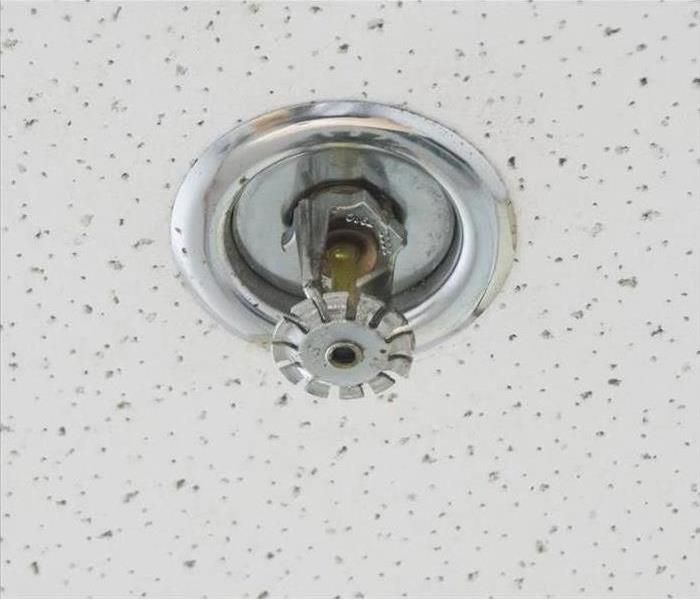 Sprinklers help to save businesses from many larger fires, but they also have the unfortunate consequence of adding additional damage to a situation.
Sprinklers help to save businesses from many larger fires, but they also have the unfortunate consequence of adding additional damage to a situation.
How Retail Stock Can Be Damaged By Fires
When picturing a fire, most people think only of the flames themselves. However, in a real fire, open flames are often among the least of your concerns. Fires are multifaceted disasters that can cause damage in multiple ways, especially in retail merchandise. Between ash, smoke, burns, and water damage, fires can damage almost any type of merchandise. SERVPRO can clean and restore many of these, but understanding what might happen to your stock during a fire is important for calculating financial loss and extra shipments.
Burned Goods
The most obvious way that items take fire damage in Hendersonville retail locations is through direct burns. Flammable items may catch fire, in most cases becoming unsalvageable, and other goods may be exposed to flames that partially or fully destroy them. We're able to restore some of the damage caused by direct burns, such as some discoloration or warping in items, but many victims of this type of damage are irrecoverable.
Water Damage from Sprinklers
Sprinklers help to save a business from many larger fires, but they also have the unfortunate consequence of adding additional damage to a situation. Water can damage most unsealed goods, and whether or not they will need replacing depends entirely on how much water is sprayed and what types of items are affected.
Ash
Ash is a tricky substance, as it can work its way into deep recesses and mix with water to become a harmful sludge. Ash is particularly bad for electronics and food items, but thankfully, its effects can usually be mitigated by SERVPRO or an affiliated contractor.
Smoke
Smoke has the highest potential to damage fabrics and clothing but can hurt other types of merchandise as well. We have many different methods of treating smoke damage, be it on an individual item or rooms at a time. Smoke is usually a more serious problem for the building itself than any merchandise.
Locally Owned Company with National Resources
SERVPRO of Sumner County is a locally-owned company with industrial-grade equipment and training capable of handling even the most serious retail fire restorations. Call us 24/7 at (615) 822-0200.






 24/7 Emergency Service
24/7 Emergency Service









